Seat Leon 5D 2012 MEDIA SYSTEM 2.2
Manufacturer: SEAT, Model Year: 2012, Model line: Leon 5D, Model: Seat Leon 5D 2012Pages: 112, PDF Size: 2 MB
Page 41 of 112
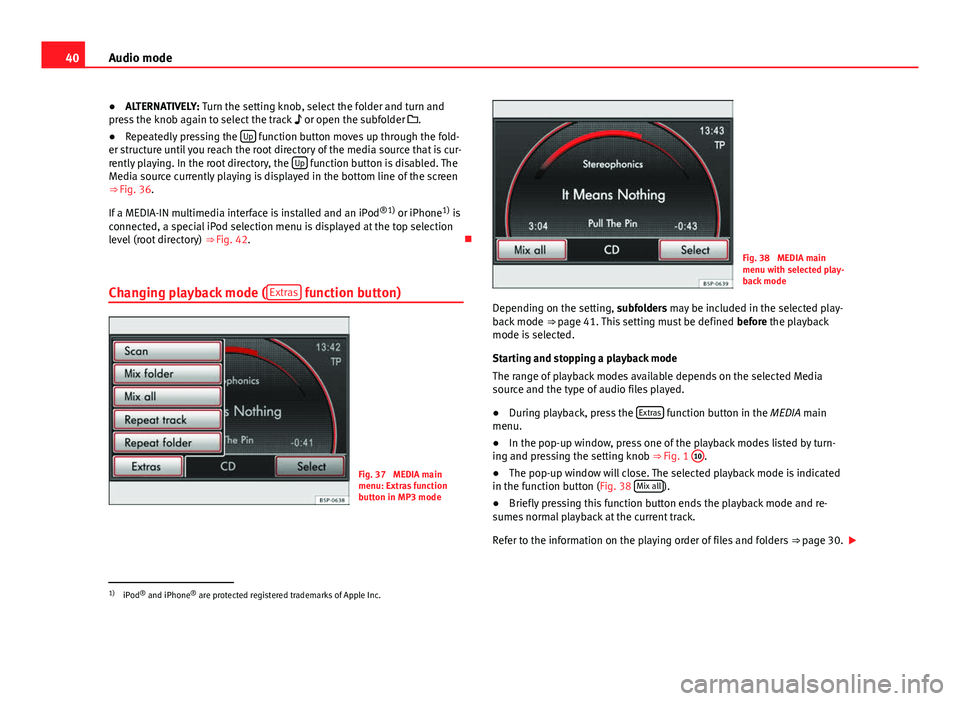
40Audio mode
ŌŚÅ ALTERNATIVELY: Turn the setting knob, select the folder and turn and
press the knob again to select the track ’ĆŻ or open the subfolder ’ü¦.
ŌŚÅ Repeatedly pressing the Up
function button moves up through the fold-
er structure until you reach the root directory of the media source that is cur-
rently playing. In the root directory, the Up
function button is disabled. The
Media source currently playing is displayed in the bottom line of the screen
ŌćÆŌĆŖFig. 36.
If a MEDIA-IN multimedia interface is installed and an iPod ®1)
or iPhone 1)
is
connected, a special iPod selection menu is displayed at the top selection
level (root directory) ŌćÆŌĆŖFig. 42. ’āÉ
Changing playback mode ( Extras
function button)
Fig. 37 MEDIA main
menu: Extras function
button in MP3 mode
Fig. 38 MEDIA main
menu with selected play-
back mode
Depending on the setting, subfolders may be included in the selected play-
back mode ŌćÆŌĆŖpage 41. This setting must be defined
before the playback
mode is selected.
Starting and stopping a playback mode
The range of playback modes available depends on the selected Media
source and the type of audio files played.
ŌŚÅ During playback, press the Extras
function button in the MEDIA main
menu.
ŌŚÅ In the pop-up window, press one of the playback modes listed by turn-
ing and pressing the setting knob ŌćÆŌĆŖFig. 1 10
.
ŌŚÅ The pop-up window will close. The selected playback mode is indicated
in the function button (Fig. 38 Mix all
).
ŌŚÅ Briefly pressing this function button ends the playback mode and re-
sumes normal playback at the current track.
Refer to the information on the playing order of files and folders ŌćÆŌĆŖpage 30.
’éŻ
1)
iPod ®
and iPhone ®
are protected registered trademarks of Apple Inc.
Page 42 of 112
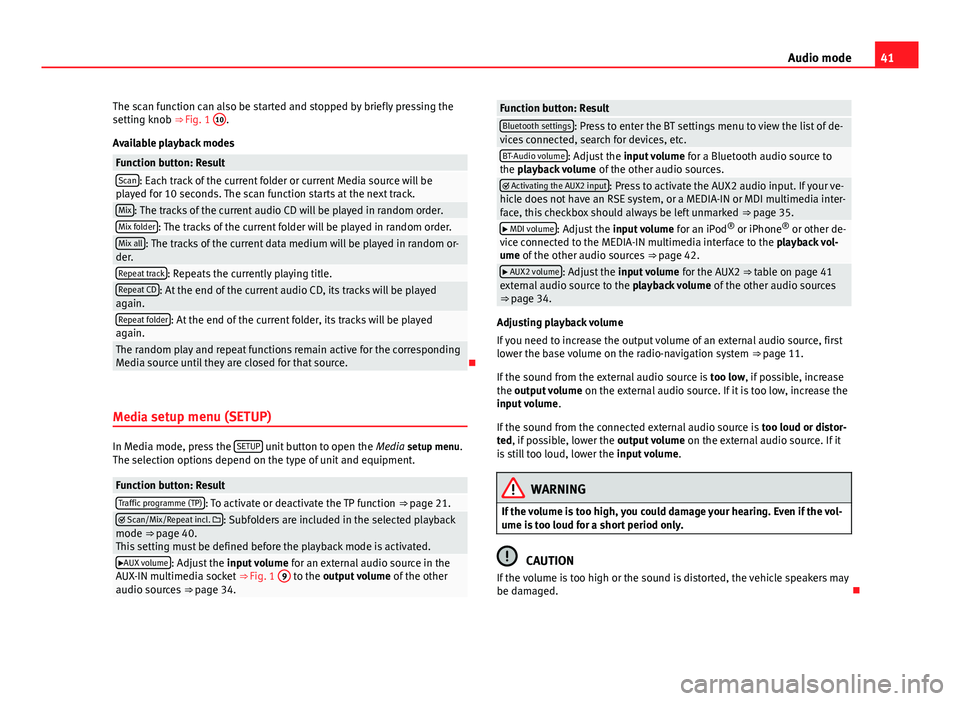
41
Audio mode
The scan function can also be started and stopped by briefly pressing the
setting knob ŌćÆŌĆŖFig. 1 10
.
Available playback modes
Function button: ResultScan: Each track of the current folder or current Media source will be
played for 10 seconds. The scan function starts at the next track.
Mix: The tracks of the current audio CD will be played in random order.Mix folder: The tracks of the current folder will be played in random order.Mix all: The tracks of the current data medium will be played in random or-
der.
Repeat track: Repeats the currently playing title.Repeat CD: At the end of the current audio CD, its tracks will be played
again.
Repeat folder: At the end of the current folder, its tracks will be played
again.
The random play and repeat functions remain active for the corresponding
Media source until they are closed for that source.’āÉ
Media setup menu (SETUP)
In Media mode, press the SETUP unit button to open the
Media setup menu.
The selection options depend on the type of unit and equipment.
Function button: ResultTraffic programme (TP): To activate or deactivate the TP function ŌćÆŌĆŖpage 21.’ā£ Scan/Mix/Repeat incl. ’ü¦: Subfolders are included in the selected playback
mode ŌćÆŌĆŖ page 40.
This setting must be defined before the playback mode is activated.
’éŻAUX volume: Adjust the input volume for an external audio source in the
AUX-IN multimedia socket ŌćÆŌĆŖFig. 1 9 to the output volume
of the other
audio sources ŌćÆŌĆŖpage 34.
Function button: ResultBluetooth settings: Press to enter the BT settings menu to view the list of de-
vices connected, search for devices, etc.
BT-Audio volume: Adjust the input volume for a Bluetooth audio source to
the playback volume of the other audio sources.
’ā£ Activating the AUX2 input: Press to activate the AUX2 audio input. If your ve-
hicle does not have an RSE system, or a MEDIA-IN or MDI multimedia inter-
face, this checkbox should always be left unmarked ŌćÆŌĆŖpage 35.
’éŻ MDI volume: Adjust the input volume for an iPod┬«
or iPhone ®
or other de-
vice connected to the MEDIA-IN multimedia interface to the playback vol-
ume of the other audio sources ŌćÆŌĆŖpage 42.
’éŻ AUX2 volume: Adjust the input volume for the AUX2 ŌćÆŌĆŖ table on page 41
external audio source to the playback volume of the other audio sources
ŌćÆŌĆŖpage 34.
Adjusting playback volume
If you need to increase the output volume of an external audio source, first
lower the base volume on the radio-navigation system ŌćÆŌĆŖpage 11.
If the sound from the external audio source is too low, if possible, increase
the output volume on the external audio source. If it is too low, increase the
input volume .
If the sound from the connected external audio source is too loud or distor-
ted, if possible, lower the output volume on the external audio source. If it
is still too loud, lower the input volume.
WARNING
If the volume is too high, you could damage your hearing. Even if the vol-
ume is too loud for a short period only.
CAUTION
If the volume is too high or the sound is distorted, the vehicle speakers may
be damaged. ’āÉ
Page 43 of 112
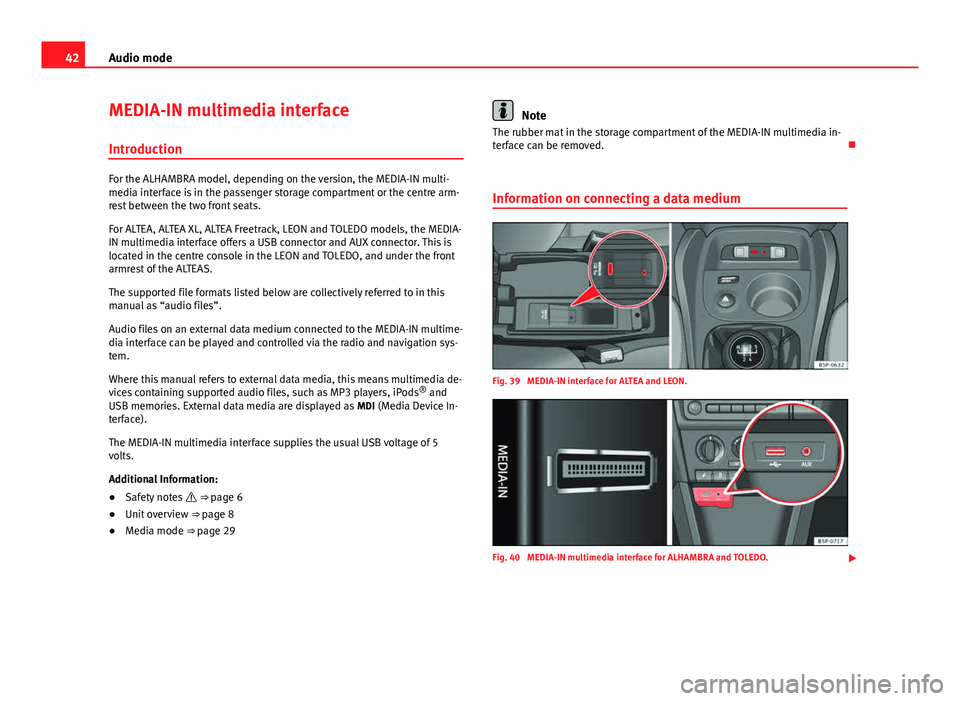
42Audio mode
MEDIA-IN multimedia interface
Introduction
For the ALHAMBRA model, depending on the version, the MEDIA-IN multi-
media interface is in the passenger storage compartment or the centre arm-
rest between the two front seats.
For ALTEA, ALTEA XL, ALTEA Freetrack, LEON and TOLEDO models, the MEDIA-
IN multimedia interface offers a USB connector and AUX connector. This is
located in the centre console in the LEON and TOLEDO, and under the front
armrest of the ALTEAS.
The supported file formats listed below are collectively referred to in this
manual as ŌĆ£audio filesŌĆØ.
Audio files on an external data medium connected to the MEDIA-IN multime-
dia interface can be played and controlled via the radio and navigation sys-
tem.
Where this manual refers to external data media, this means multimedia de-
vices containing supported audio files, such as MP3 players, iPods ®
and
USB memories. External data media are displayed as MDI (Media Device In-
terface).
The MEDIA-IN multimedia interface supplies the usual USB voltage of 5
volts.
Additional Information:
ŌŚÅ Safety notes ’ā£ ŌćÆŌĆŖpage 6
ŌŚÅ Unit overview ŌćÆŌĆŖpage 8
ŌŚÅ Media mode ŌćÆŌĆŖpage 29
Note
The rubber mat in the storage compartment of the MEDIA-IN multimedia in-
terface can be removed. ’āÉ
Information on connecting a data medium
Fig. 39 MEDIA-IN interface for ALTEA and LEON.
Fig. 40 MEDIA-IN multimedia interface for ALHAMBRA and TOLEDO. ’éŻ
Page 44 of 112
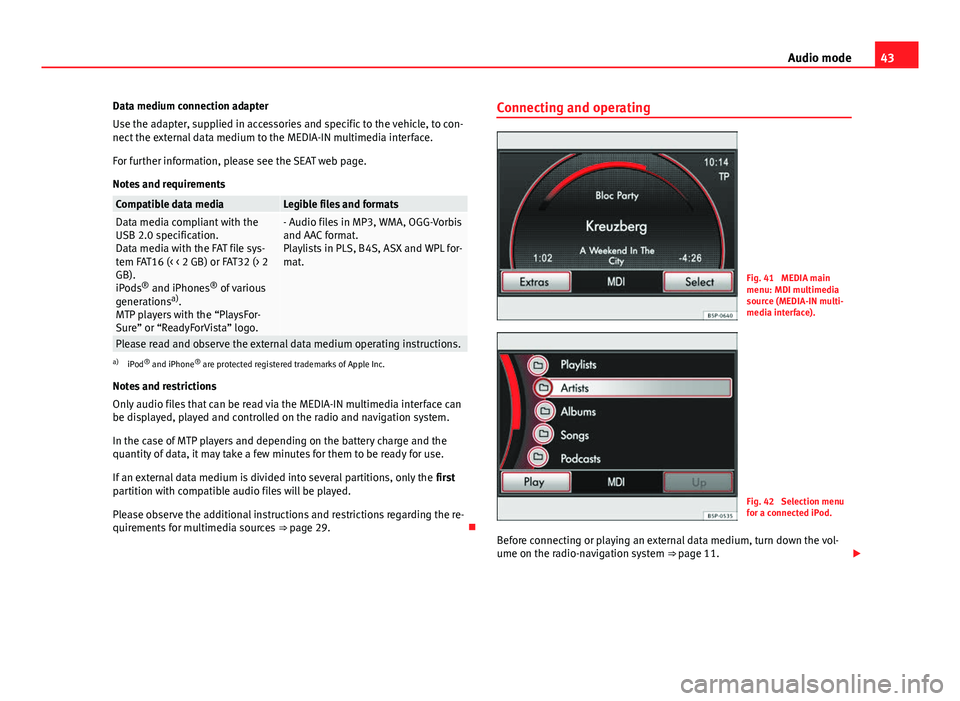
43
Audio mode
Data medium connection adapter
Use the adapter, supplied in accessories and specific to the vehicle, to con-
nect the external data medium to the MEDIA-IN multimedia interface.
For further information, please see the SEAT web page.
Notes and requirements
Compatible data mediaLegible files and formatsData media compliant with the
USB 2.0 specification.
Data media with the FAT file sys-
tem FAT16 (< < 2 GB) or FAT32 (> 2
GB).
iPods ®
and iPhones ®
of various
generations a)
.
MTP players with the ŌĆ£PlaysFor-
SureŌĆØ or ŌĆ£ReadyForVistaŌĆØ logo.- Audio files in MP3, WMA, OGG-Vorbis
and AAC format.
Playlists in PLS, B4S, ASX and WPL for-
mat.
Please read and observe the external data medium operating instructions.a) iPod ®
and iPhone ®
are protected registered trademarks of Apple Inc.
Notes and restrictions
Only audio files that can be read via the MEDIA-IN multimedia interface can
be displayed, played and controlled on the radio and navigation system.
In the case of MTP players and depending on the battery charge and the
quantity of data, it may take a few minutes for them to be ready for use.
If an external data medium is divided into several partitions, only the first
partition with compatible audio files will be played.
Please observe the additional instructions and restrictions regarding the re-
quirements for multimedia sources ŌćÆŌĆŖpage 29. ’āÉConnecting and operating
Fig. 41 MEDIA main
menu: MDI multimedia
source (MEDIA-IN multi-
media interface).
Fig. 42 Selection menu
for a connected iPod.
Before connecting or playing an external data medium, turn down the vol-
ume on the radio-navigation system ŌćÆŌĆŖpage 11. ’éŻ
Page 45 of 112
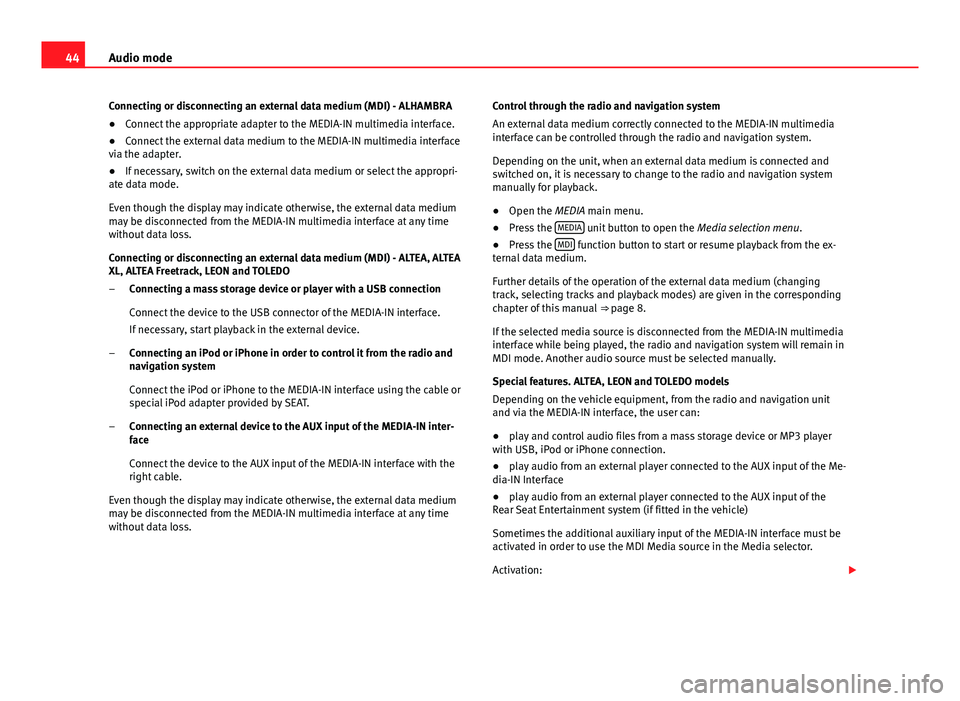
44Audio mode
Connecting or disconnecting an external data medium (MDI) - ALHAMBRA
ŌŚÅ Connect the appropriate adapter to the MEDIA-IN multimedia interface.
ŌŚÅ Connect the external data medium to the MEDIA-IN multimedia interface
via the adapter.
ŌŚÅ If necessary, switch on the external data medium or select the appropri-
ate data mode.
Even though the display may indicate otherwise, the external data medium
may be disconnected from the MEDIA-IN multimedia interface at any time
without data loss.
Connecting or disconnecting an external data medium (MDI) - ALTEA, ALTEA
XL, ALTEA Freetrack, LEON and TOLEDO
Connecting a mass storage device or player with a USB connection
Connect the device to the USB connector of the MEDIA-IN interface.
If necessary, start playback in the external device.
Connecting an iPod or iPhone in order to control it from the radio and
navigation system
Connect the iPod or iPhone to the MEDIA-IN interface using the cable or
special iPod adapter provided by SEAT.
Connecting an external device to the AUX input of the MEDIA-IN inter-
face
Connect the device to the AUX input of the MEDIA-IN interface with the
right cable.
Even though the display may indicate otherwise, the external data medium
may be disconnected from the MEDIA-IN multimedia interface at any time
without data loss. ŌĆō
ŌĆō
ŌĆō Control through the radio and navigation system
An external data medium correctly connected to the MEDIA-IN multimedia
interface can be controlled through the radio and navigation system.
Depending on the unit, when an external data medium is connected and
switched on, it is necessary to change to the radio and navigation system
manually for playback.
ŌŚÅ
Open the MEDIA main menu.
ŌŚÅ Press the MEDIA
unit button to open the
Media selection menu.
ŌŚÅ Press the MDI function button to start or resume playback from the ex-
ternal data medium.
Further details of the operation of the external data medium (changing
track, selecting tracks and playback modes) are given in the corresponding
chapter of this manual ŌćÆŌĆŖpage 8.
If the selected media source is disconnected from the MEDIA-IN multimedia
interface while being played, the radio and navigation system will remain in
MDI mode. Another audio source must be selected manually.
Special features. ALTEA, LEON and TOLEDO models
Depending on the vehicle equipment, from the radio and navigation unit
and via the MEDIA-IN interface, the user can:
ŌŚÅ play and control audio files from a mass storage device or MP3 player
with USB, iPod or iPhone connection.
ŌŚÅ play audio from an external player connected to the AUX input of the Me-
dia-IN Interface
ŌŚÅ play audio from an external player connected to the AUX input of the
Rear Seat Entertainment system (if fitted in the vehicle)
Sometimes the additional auxiliary input of the MEDIA-IN interface must be
activated in order to use the MDI Media source in the Media selector.
Activation: ’éŻ
Page 46 of 112
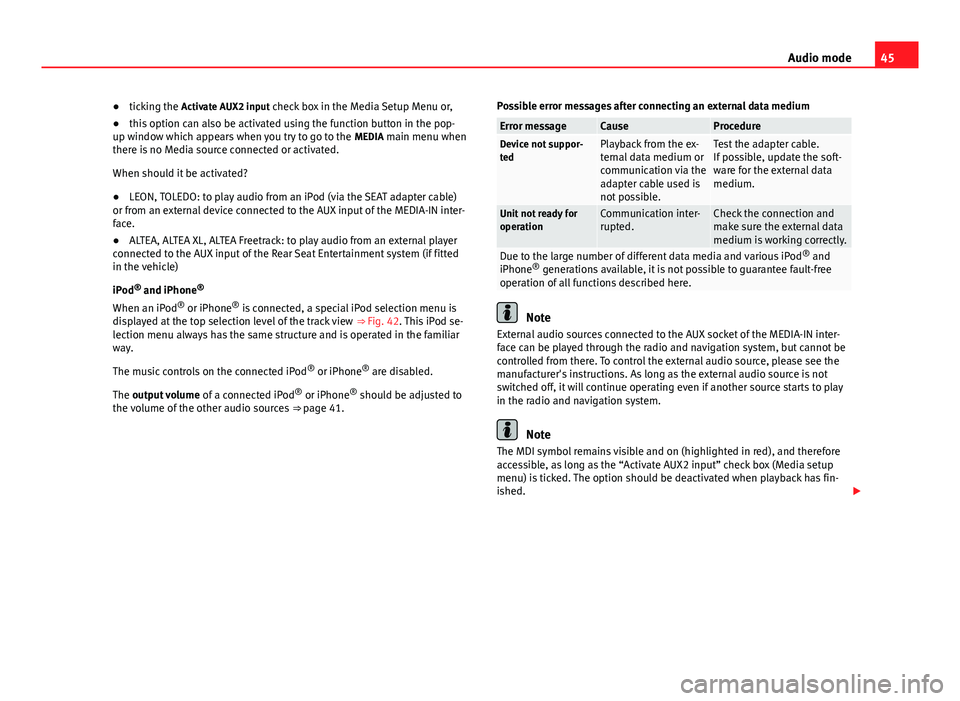
45
Audio mode
ŌŚÅ ticking the Activate AUX2 input check box in the Media Setup Menu or,
ŌŚÅ this option can also be activated using the function button in the pop-
up window which appears when you try to go to the MEDIA main menu when
there is no Media source connected or activated.
When should it be activated?
ŌŚÅ LEON, TOLEDO: to play audio from an iPod (via the SEAT adapter cable)
or from an external device connected to the AUX input of the MEDIA-IN inter-
face.
ŌŚÅ ALTEA, ALTEA XL, ALTEA Freetrack: to play audio from an external player
connected to the AUX input of the Rear Seat Entertainment system (if fitted
in the vehicle)
iPod ®
and iPhone ®
When an iPod ®
or iPhone ®
is connected, a special iPod selection menu is
displayed at the top selection level of the track view ŌćÆŌĆŖFig. 42. This iPod se-
lection menu always has the same structure and is operated in the familiar
way.
The music controls on the connected iPod ®
or iPhone ®
are disabled.
The output volume of a connected iPod ®
or iPhone ®
should be adjusted to
the volume of the other audio sources ŌćÆŌĆŖpage 41. Possible error messages after connecting an external data medium
Error messageCauseProcedureDevice not suppor-
tedPlayback from the ex-
ternal data medium or
communication via the
adapter cable used is
not possible.Test the adapter cable.
If possible, update the soft-
ware for the external data
medium.
Unit not ready for
operationCommunication inter-
rupted.Check the connection and
make sure the external data
medium is working correctly.
Due to the large number of different data media and various iPod
®
and
iPhone ®
generations available, it is not possible to guarantee fault-free
operation of all functions described here.
Note
External audio sources connected to the AUX socket of the MEDIA-IN inter-
face can be played through the radio and navigation system, but cannot be
controlled from there. To control the external audio source, please see the
manufacturer's instructions. As long as the external audio source is not
switched off, it will continue operating even if another source starts to play
in the radio and navigation system.
Note
The MDI symbol remains visible and on (highlighted in red), and therefore
accessible, as long as the ŌĆ£Activate AUX2 inputŌĆØ check box (Media setup
menu) is ticked. The option should be deactivated when playback has fin-
ished. ’éŻ
Page 47 of 112
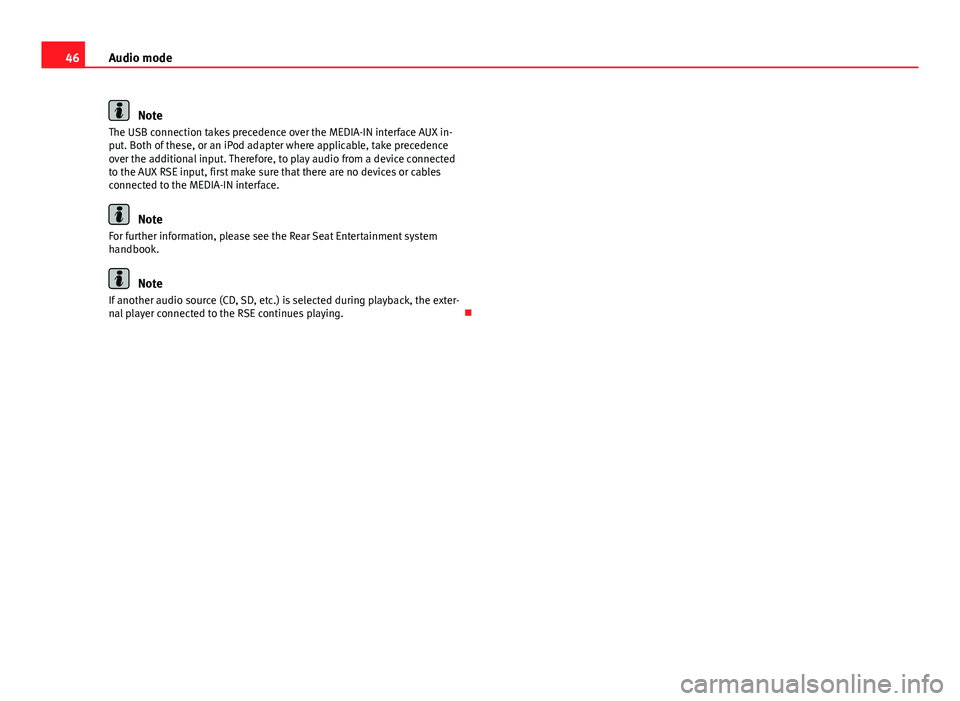
46Audio mode
Note
The USB connection takes precedence over the MEDIA-IN interface AUX in-
put. Both of these, or an iPod adapter where applicable, take precedence
over the additional input. Therefore, to play audio from a device connected
to the AUX RSE input, first make sure that there are no devices or cables
connected to the MEDIA-IN interface.
Note
For further information, please see the Rear Seat Entertainment system
handbook.
Note
If another audio source (CD, SD, etc.) is selected during playback, the exter-
nal player connected to the RSE continues playing. ’āÉ
Page 48 of 112
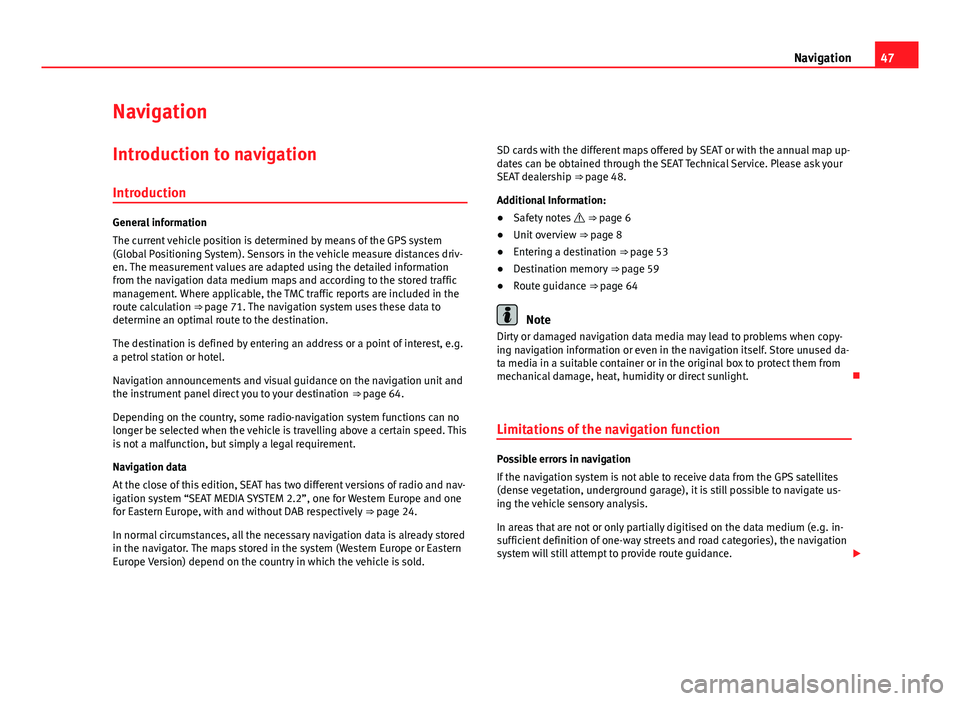
47
Navigation
Navigation Introduction to navigation
Introduction
General information
The current vehicle position is determined by means of the GPS system
(Global Positioning System). Sensors in the vehicle measure distances driv-
en. The measurement values are adapted using the detailed information
from the navigation data medium maps and according to the stored traffic
management. Where applicable, the TMC traffic reports are included in the
route calculation ŌćÆŌĆŖpage 71. The navigation system uses these data to
determine an optimal route to the destination.
The destination is defined by entering an address or a point of interest, e.g.
a petrol station or hotel.
Navigation announcements and visual guidance on the navigation unit and
the instrument panel direct you to your destination ŌćÆŌĆŖpage 64.
Depending on the country, some radio-navigation system functions can no
longer be selected when the vehicle is travelling above a certain speed. This
is not a malfunction, but simply a legal requirement.
Navigation data
At the close of this edition, SEAT has two different versions of radio and nav-
igation system ŌĆ£SEAT MEDIA SYSTEM 2.2ŌĆØ, one for Western Europe and one
for Eastern Europe, with and without DAB respectively ŌćÆŌĆŖpage 24.
In normal circumstances, all the necessary navigation data is already stored
in the navigator. The maps stored in the system (Western Europe or Eastern
Europe Version) depend on the country in which the vehicle is sold. SD cards with the different maps offered by SEAT or with the annual map up-
dates can be obtained through the SEAT Technical Service. Please ask your
SEAT dealership ŌćÆŌĆŖpage 48.
Additional Information:
ŌŚÅ
Safety notes ’ā£ ŌćÆŌĆŖpage 6
ŌŚÅ Unit overview ŌćÆŌĆŖpage 8
ŌŚÅ Entering a destination ŌćÆŌĆŖpage 53
ŌŚÅ Destination memory ŌćÆŌĆŖpage 59
ŌŚÅ Route guidance ŌćÆŌĆŖpage 64
Note
Dirty or damaged navigation data media may lead to problems when copy-
ing navigation information or even in the navigation itself. Store unused da-
ta media in a suitable container or in the original box to protect them from
mechanical damage, heat, humidity or direct sunlight. ’āÉ
Limitations of the navigation function
Possible errors in navigation
If the navigation system is not able to receive data from the GPS satellites
(dense vegetation, underground garage), it is still possible to navigate us-
ing the vehicle sensory analysis.
In areas that are not or only partially digitised on the data medium (e.g. in-
sufficient definition of one-way streets and road categories), the navigation
system will still attempt to provide route guidance. ’éŻ
Page 49 of 112
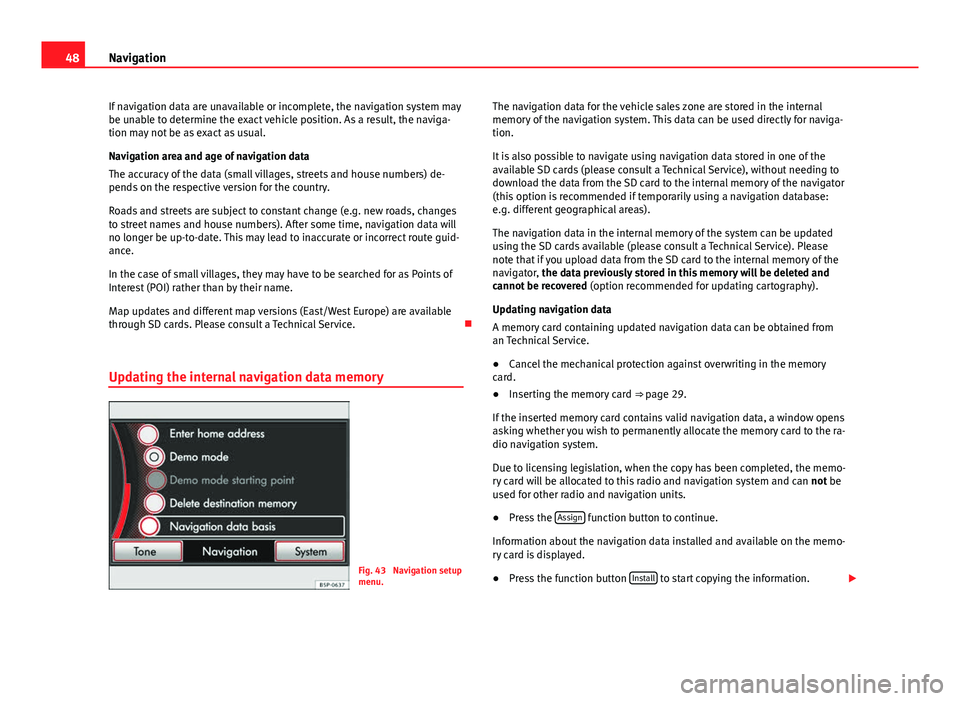
48Navigation
If navigation data are unavailable or incomplete, the navigation system may
be unable to determine the exact vehicle position. As a result, the naviga-
tion may not be as exact as usual.
Navigation area and age of navigation data
The accuracy of the data (small villages, streets and house numbers) de-
pends on the respective version for the country.
Roads and streets are subject to constant change (e.g. new roads, changes
to street names and house numbers). After some time, navigation data will
no longer be up-to-date. This may lead to inaccurate or incorrect route guid-
ance.
In the case of small villages, they may have to be searched for as Points of
Interest (POI) rather than by their name.
Map updates and different map versions (East/West Europe) are available
through SD cards. Please consult a Technical Service. ’āÉ
Updating the internal navigation data memory
Fig. 43 Navigation setup
menu. The navigation data for the vehicle sales zone are stored in the internal
memory of the navigation system. This data can be used directly for naviga-
tion.
It is also possible to navigate using navigation data stored in one of the
available SD cards (please consult a Technical Service), without needing to
download the data from the SD card to the internal memory of the navigator
(this option is recommended if temporarily using a navigation database:
e.g. different geographical areas).
The navigation data in the internal memory of the system can be updated
using the SD cards available (please consult a Technical Service). Please
note that if you upload data from the SD card to the internal memory of the
navigator, the data previously stored in this memory will be deleted and
cannot be recovered
(option recommended for updating cartography).
Updating navigation data
A memory card containing updated navigation data can be obtained from
an Technical Service.
ŌŚÅ Cancel the mechanical protection against overwriting in the memory
card.
ŌŚÅ Inserting the memory card ŌćÆŌĆŖpage 29.
If the inserted memory card contains valid navigation data, a window opens
asking whether you wish to permanently allocate the memory card to the ra-
dio navigation system.
Due to licensing legislation, when the copy has been completed, the memo-
ry card will be allocated to this radio and navigation system and can not be
used for other radio and navigation units.
ŌŚÅ Press the Assign
function button to continue.
Information about the navigation data installed and available on the memo-
ry card is displayed.
ŌŚÅ Press the function button Install
to start copying the information.
’éŻ
Page 50 of 112
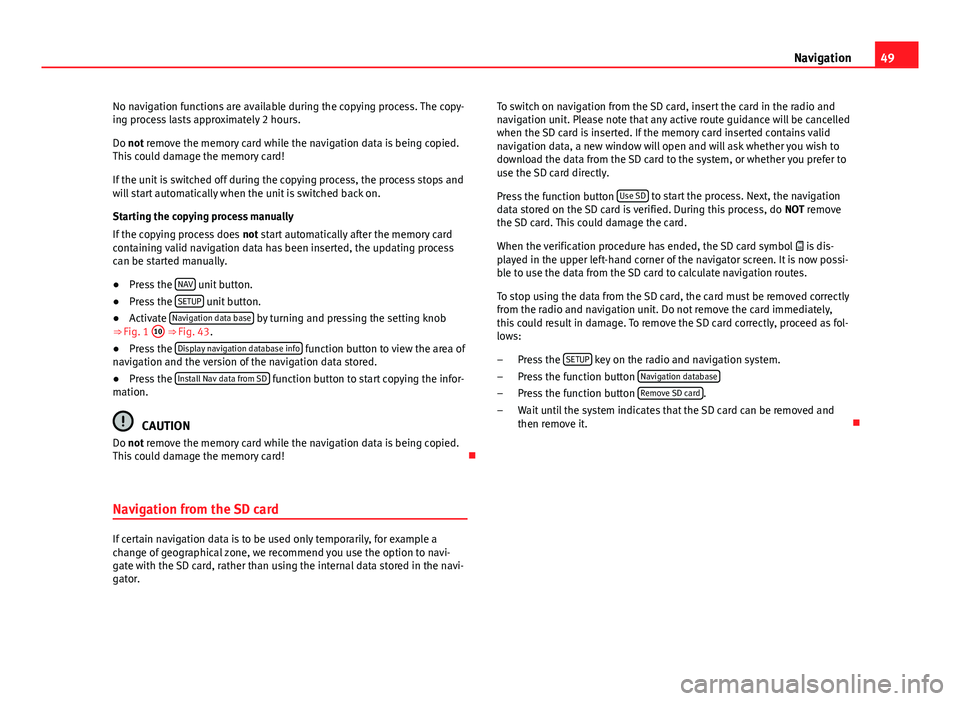
49
Navigation
No navigation functions are available during the copying process. The copy-
ing process lasts approximately 2 hours.
Do not remove the memory card while the navigation data is being copied.
This could damage the memory card!
If the unit is switched off during the copying process, the process stops and
will start automatically when the unit is switched back on.
Starting the copying process manually
If the copying process does not start automatically after the memory card
containing valid navigation data has been inserted, the updating process
can be started manually.
ŌŚÅ Press the NAV
unit button.
ŌŚÅ Press the SETUP unit button.
ŌŚÅ Activate Navigation data base by turning and pressing the setting knob
ŌćÆŌĆŖFig. 1 10 ŌćÆŌĆŖ
Fig. 43.
ŌŚÅ Press the Display navigation database info function button to view the area of
navigation and the version of the navigation data stored.
ŌŚÅ Press the Install Nav data from SD
function button to start copying the infor-
mation.
CAUTION
Do not remove the memory card while the navigation data is being copied.
This could damage the memory card! ’āÉ
Navigation from the SD card
If certain navigation data is to be used only temporarily, for example a
change of geographical zone, we recommend you use the option to navi-
gate with the SD card, rather than using the internal data stored in the navi-
gator. To switch on navigation from the SD card, insert the card in the radio and
navigation unit. Please note that any active route guidance will be cancelled
when the SD card is inserted. If the memory card inserted contains valid
navigation data, a new window will open and will ask whether you wish to
download the data from the SD card to the system, or whether you prefer to
use the SD card directly.
Press the function button
Use SD
to start the process. Next, the navigation
data stored on the SD card is verified. During this process, do NOT remove
the SD card. This could damage the card.
When the verification procedure has ended, the SD card symbol ’ü½ is dis-
played in the upper left-hand corner of the navigator screen. It is now possi-
ble to use the data from the SD card to calculate navigation routes.
To stop using the data from the SD card, the card must be removed correctly
from the radio and navigation unit. Do not remove the card immediately,
this could result in damage. To remove the SD card correctly, proceed as fol-
lows:
Press the SETUP
key on the radio and navigation system.
Press the function button Navigation database
Press the function button Remove SD card.
Wait until the system indicates that the SD card can be removed and
then remove it. ’āÉ
ŌĆō
ŌĆō
ŌĆō
ŌĆō